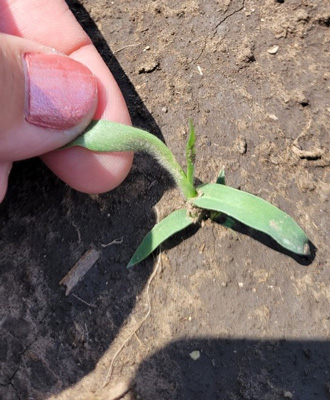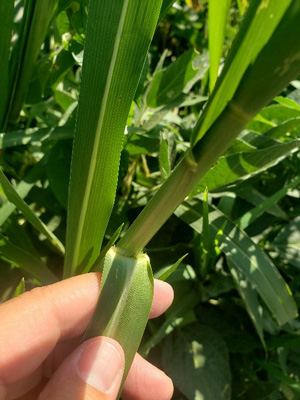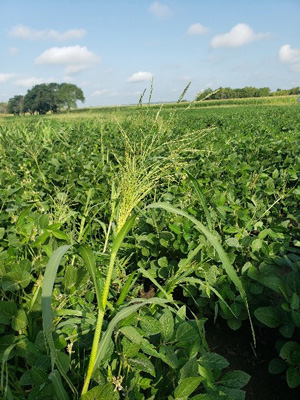While walking corn fields in central and eastern Kansas last summer, I noticed several infestations of fall panicum, also known as smooth witchgrass. As the common name implies, fall panicum is in the genus Panicum, which also includes switchgrass and other ornamental grasses.
Ecology
Fall panicum (Panicum dichotomiflorum) is a summer annual grass native to eastern North America. It is found throughout the U.S. in most soil types. Fall panicum can tolerate compaction and tends to be more prevalent in wetter soils. Due to its requirement for warm soils, it germinates in late spring or summer. However, due to nitrate accumulation, it can be harmful to livestock.
Identification
Fall panicum seedlings may have a purple hue but are distinguished by many hairs on the lower surface of leaf blades (Figure 1). This characteristic is not present in the mature plant.

Figure 1. Seedlings have dense hairs on the lower leaf surface. Photo by Sarah Lancaster, K-State Research and Extension.
The ligule is a fringe of hairs with no auricles (Figure 2). The leaf sheath is loose, purple-tinged, and hairless.

Figure 2. The ligule is a fringe of hairs. Also, note the prominent white midrib. Photo by Sarah Lancaster, K-State Research and Extension.
Fall panicum stems are round and smooth, typically up to four feet tall, but can reach up to seven feet tall. Fall panicum can root from the nodes and stems often have a bend at the nodes, giving the plant a somewhat zigzag appearance.
Mature leaves of fall panicum have a conspicuous white midvein and are 4 to 35 inches long and up to 1 inch wide. They may have hairs near the tip and/or base but are generally hairless. Plants of both species.
The seedhead is an open panicle 3 to 16 inches long (Figure 3). Panicles of fall panicum can form at the top of the stem, at the ends of branches, and even at the base of a leaf. When mature, a single plant can produce up to 500,000 football-shaped yellow seeds with a purple tint.

Figure 3. Note the open panicle at the top of the plant. Photo by Sarah Lancaster, K-State Research and Extension.
Management
Fall panicum is not well controlled by atrazine due to its ability to metabolize the herbicide and is less sensitive to glyphosate than other grasses. However, S-metolachlor (Dual, others) and acetochlor (Harness, others) generally provide suitable control. No herbicide resistance has been reported for fall panicum in Kansas. However, ALS resistance was recently reported in fall panicum from Wisconsin.
Because fall panicum emerges late, weed growth can be suppressed by practices such as planting corn early, which facilitates a dense crop canopy before weed emergence. Planting winter cereals has also been recommended for fall panicum suppression.
The use of trade names is for clarity to readers and does not imply endorsement of a particular product, nor does exclusion imply non-approval. Always consult the herbicide label for the most current use requirements. Users should read and follow all label instructions.
Sarah Lancaster, Extension Weed Management Specialist
slancaster@ksu.edu
Tags: World of Weeds weeds fall panicum